2020 MERCEDES-BENZ CLA wheel
[x] Cancel search: wheelPage 407 of 570
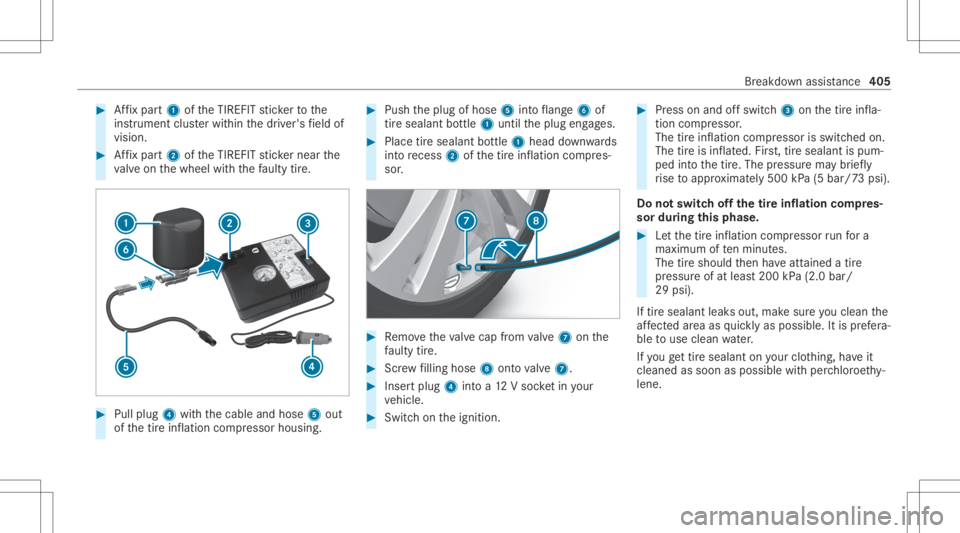
#
Affix pa rt1 oftheTIREFI Tst icke rto the
ins trumen tclus terwit hin thedr iver's field of
vision. #
Affix pa rt2 oftheTIREFI Tst icke rnear the
va lve on thewheel withth efa ulty tire. #
Pull plug 4withth ecable andhose 5out
of thetir einf lation compressor housing. #
Push theplug ofhose 5intoflang e6 of
tir esealan tbo ttle 1 untilth eplug engages. #
Place tiresealant bottle 1 head down wards
int ore cess 2ofthetir einf lation compres‐
sor . #
Remo vetheva lve cap from valve 7 onthe
fa ulty tire. #
Screw filling hose 8ontova lve 7. #
Insertplug 4intoa12 Vsoc ketin your
ve hicle. #
Switc hon theignition . #
Press onand offswitc h3 onthetir einf la‐
tion compressor .
The tireinf lation compressor isswitc hedon.
The tireis inf lated. First,tir esealant ispum‐
ped intoth etir e. The pressur ema ybr ief ly
ri se toappr oximat ely500 kPa(5 bar/7 3psi).
Do notswitc hof fth etir einflat ioncom pres‐
sor during this pha se. #
Letth etir einf lation compressor runfo ra
maximu mof tenminu tes.
The tireshould then have attaine datir e
pr essur eof at leas t20 0kP a(2. 0bar/
29 psi).
If tir esealan tleak sout ,mak esur eyo ucle an the
af fect ed area asquickl yas possible .It is prefer a‐
ble touse clean water.
If yo uge ttir ese alant onyour clo thing, have it
clean edassoon aspossible withper chlor oethy‐
len e. Br
eak down assi stanc e405
Page 415 of 570
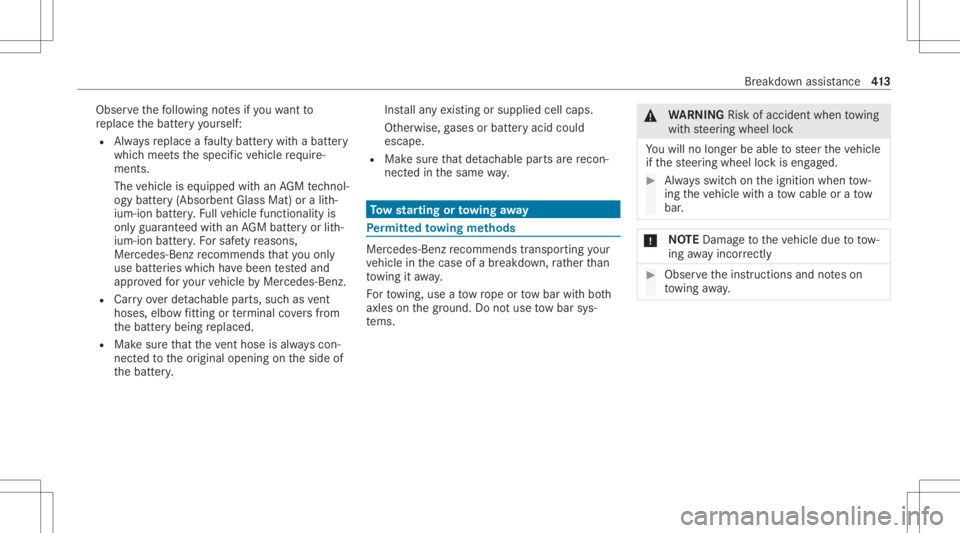
Obser
vethefo llo wing notesif yo uwa ntto
re place thebatt eryyo urself :
R Alw aysre place afa ulty battery wit habatt ery
whic hmee tsthespecif icvehicle requ ire‐
men ts.
The vehicle iseq uipped withan AGMtech nol ‐
ogy batter y(A bso rbentGlas sMa t)or alith ‐
ium-io nbatt ery. Fu llve hicle functionality is
onl yguar anteed withan AGMbatt eryor lith‐
ium-ion battery. Fo rsaf etyre ason s,
Mer cedes-Ben zre comme ndsthat youon ly
use batteries whic hha ve been tested and
appr ovedfo ryo ur vehicle byMer cedes-Ben z.
R Carryove rde tach able parts,suc has vent
hos es,elbo wfitting orterm inal covers from
th ebatt erybeing replaced.
R Mak esur eth at theve nt hos eis alwa ys con‐
nect edtotheor iginal opening ontheside of
th ebatt ery. Ins
tallan yex istin gor supplied cellcaps.
Ot her wise, gases orbatt eryacid could
escape.
R Mak esur eth at detach able partsarere con‐
nect edinthesame way. To
w star ting ortowing away Pe
rm itted towing methods Mer
cede s-Ben zre comme ndstransp orting your
ve hicle inthecase ofabr eakdo wn,rath er than
to wing itaw ay.
Fo rto wing, useato w rope ortow bar withbo th
axle son thegr ound. Donotuse tow bar sys‐
te ms. &
WARNIN GRisk ofacci dent whento wing
wit hsteer ing wheel lock
Yo uwill nolongerbe ableto steer theve hicle
if th esteer ing wheel lockis eng aged. #
Alw aysswitc hon theignition whentow‐
ing theve hicle withato w cable orato w
bar . *
NO
TEDama getotheve hicle duetotow‐
ing away inc orrectl y #
Obs erve theins truction sand noteson
to wing away. Br
ea kdo wnassista nce 41
3
Page 418 of 570
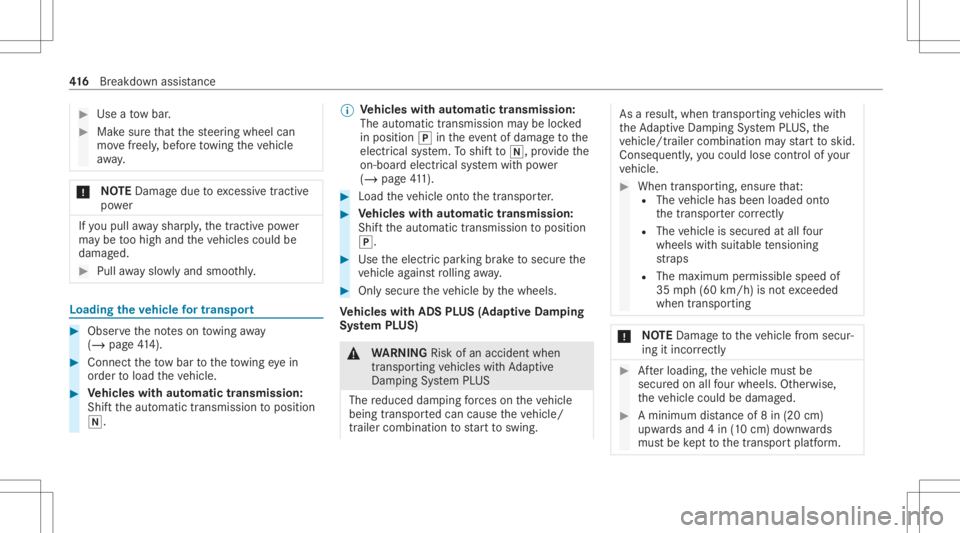
#
Use ato w bar . #
Mak esur eth at thesteer ing wheel can
mo vefreely ,bef oreto wing theve hicle
aw ay. *
NO
TEDama gedue toexcess ive tracti ve
po we r If
yo upull away shar ply, thetractiv epo we r
ma ybe toohigh andtheve hicles couldbe
damag ed. #
Pull away slo wlyand smoo thly. Lo
adi ng the vehicl efo rtr ans port #
Obser vetheno teson towing away
( / pag e41 4). #
Con nect theto w bar totheto wing eyein
or der toload theve hicle. #
Vehicl eswith automatic transmiss ion:
Shif tth eaut omatic transmiss iontoposition
005C. %
Ve
hicl eswith automatic transmiss ion:
The automatic transmiss ionmaybe locked
in posit ion005Dintheeve ntofdama getothe
electr icalsystem. Toshif tto 005C ,pr ov ide the
on-boar delectr icalsystem withpo we r
( / pag e41 1). #
Load theve hicle ontoth etra nspor ter. #
Vehicl eswith automatic transmiss ion:
Shif tth eaut omatic transmiss iontoposition
005D. #
Use theelectr icpar king brak eto secur eth e
ve hicle agains tro lling away. #
Onlysecur eth eve hicle bythewheels.
Ve hicl eswith ADSPL US (Adap tiveDam ping
Sy stem PLUS) &
WARNIN GRisk ofan acci dent when
tr ansp orting vehicles withAd aptive
Dam pingSy stem PLUS
The reduced damping forc es on theve hicle
being transpor tedcan cause theve hicle/
tr ailer combination tostar tto swing. As
are sult, when transpor tingvehicles with
th eAd aptiveDam pingSy stem PLUS, the
ve hicle/tr ailercombination mayst ar tto skid.
Conseq uently,yo uco uld lose contro lof your
ve hicle. #
When transpor ting,ensur eth at:
R The vehicle hasbeen loaded onto
th etranspor tercor rectl y
R The vehicle issecur edatall four
wheel swit hsuit able tensi oni ng
st ra ps
R The maximum permissible speedof
35 mph(6 0km/h) isno texc eeded
when transpor ting *
NO
TEDama getotheve hicle from secur‐
ing itincor rectl y #
Afterloa ding, theve hicle mustbe
secur edon allfour wheel s.Ot her wise,
th eve hicle could bedamag ed. #
Aminimum distance of8in (20 cm)
up wa rdsand 4in (10 cm) down wards
mus tbe kept tothetranspor tplatf orm. 41
6
Brea kdo wnassista nce
Page 419 of 570
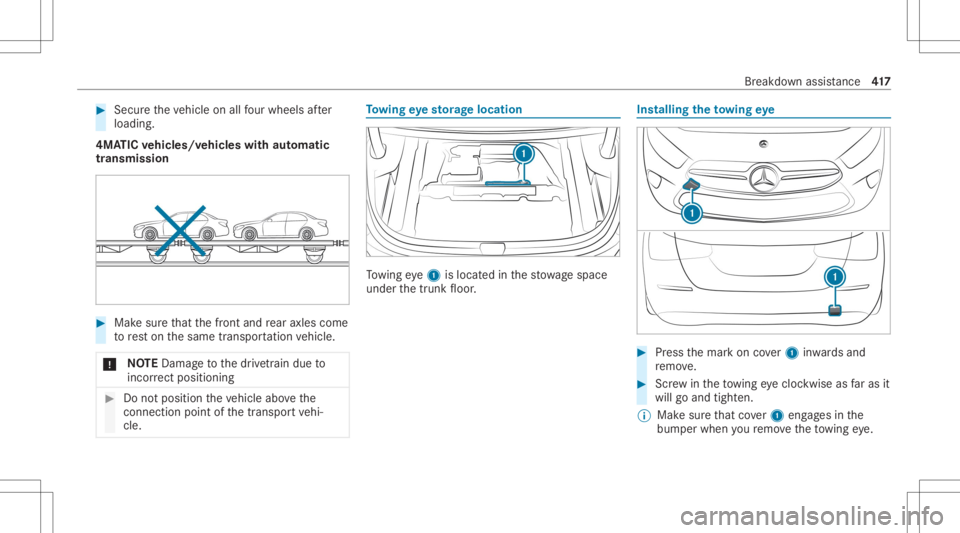
#
Secu retheve hicle onallfour wheel saf te r
loading .
4MA TICvehicl es/vehicl eswith automatic
tr ansmiss ion #
Mak esur eth at thefront and rear axle scom e
to rest on thesame transpor tatio nve hicle.
* NO
TEDama getothedr ivet ra in due to
inc orrect pos itioning #
Donotpos ition theve hicle abovethe
connecti onpointofthetranspor tve hi‐
cle. To
wing eyesto rage location To
wing eye1 islocat edinthestow agespac e
unde rth etrunk floor . Ins
talling theto wing eye #
Press themar kon cover1 inwa rdsand
re mo ve. #
Screw intheto wing eyecloc kwiseasfaras it
wil lgo and tight en.
% Mak esur eth at cover1 eng ages inthe
bum perwhen youre mo vetheto wing eye. Br
eakdo wnassis tance 41
7
Page 424 of 570

No
teson noise orunusua lhand lingcharac‐
te rist ics
While driving ,pa yatt ent ion tovibr ations, noises
and unusu alhandl ingcharact eristic s,e.g .pullin g
to one side. Thismayindicat eth at thewheels or
tir es aredamag ed.Ifyo ususpe ctthat atir eis
def ective, reduce your spee dimm ediat ely. Stop
th eve hicle assoon aspossible tocheckth e
wheels andtires fordama ge.Hid den tireda m‐
ag ecou ldalso be cau sing theunusual handling
ch aract eristic s.Ifyo ufind nosigns ofdamag e,
ha ve thetir es and wheels checkedat aqu alif ied
spec ialistwo rkshop. No
teson regular lyinspect ingwheels and
tir es &
WARNIN GRisk ofacci dent from dam‐
ag ed tires
Dama gedtir es can cause tirepr essur eloss.
As are sult, youco uld lose contro lof your
ve hicle. #
Chec kth etir es regular lyforsigns of
dama geand replace anydamag edtires
immediat ely. &
WARNIN GRisk ofaquaplani ng dueto
insuf ficie nttiretrea d
Insu fficien ttir etread willresult inreduced
tir egr ip. The tiretread isno long erable to
dissipat ewa ter.
This means that inhea vyrain or slush the
ri sk ofhydroplaning isincr eased, inpar ticu‐
lar ifve hicle speed isno tadap tedto suit the
condi tions.
If th etir epr essur eis toohigh ortoolow,
tir es ma yex hibit differe nt leve ls of we arat
dif fere nt locati ons onthetir econ tact sur‐
fa ce. #
Thu s,yo usho uld regular lych eckth e
tr ea dde pthand thecon dition ofthetir e
con tact surface across theent ire widt h
of all tires. Minimum
tread depthfor:
R Summ ertires: 00CEin(3 mm)
R M+S tires: 00CFin(4 mm) #
Forsaf etyre ason s,replace thetir es
bef oreth eleg ally prescr ibed limit for
th eminimum tread depthisreac hed. Car
ryout thefo llo wing checks on allwheels reg‐
ular ly,at leas tonce amont hor as requ ired, e.g.
pr ior toalon gjo ur ne yor drivin gof f-ro ad:
R Chec kth etir epr essur e(/ page42 4).
R Visual lyinsp ectwheels andtires fordama ge.
R Chec kth eva lve caps.
The valves mus tbe protect edagains tmois‐
tur eand dirtby theva lve caps approved
especiall yfo ryo ur vehicle byMer cedes-Ben z.
R Visual checkof thetir etread depthand the
tir econt actsurface across theent ire widt h.
The minimum tread depthforsummer tires is
00CE in(3 mm) andforwint ertires 00CF in
(4 mm). 422
Wheel sand tires
Page 425 of 570
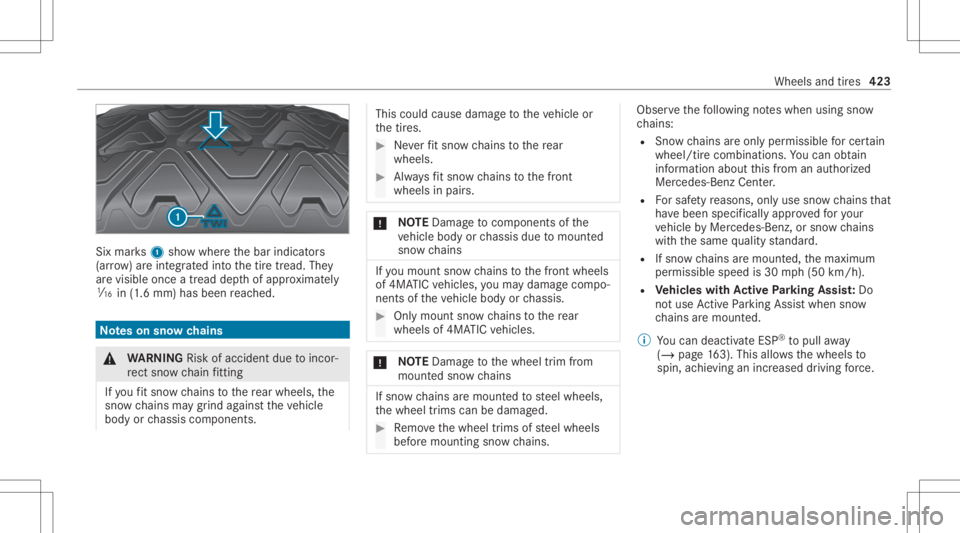
Six
mar ks1 showwher eth ebar indicat ors
(ar row )ar eint egr ated intoth etir etread. They
ar evisible onceatread depthofappr oximat ely
00CD in(1.6 mm) hasbeen reac hed. No
teson sno wch ains &
WARNIN GRisk ofacci dent dueto inc or‐
re ct sno wch ain fitting
If yo ufit sno wch ains tothere ar wheels ,th e
sno wch ains maygr ind agains tth eve hicle
body orchassis components. This
couldcaus edamag eto theve hicle or
th etir es. #
Neverfit sno wch ains tothere ar
wheels . #
Alw aysfit sno wch ains tothefront
wheels inpair s. *
NO
TEDama getocom pone ntsofthe
ve hicle body orchassis duetomount ed
sno wch ains If
yo umoun tsn ow chains tothefront wheels
of 4MA TICvehicles, youma ydamag eco mp o‐
nent sof theve hicle body orchassis . #
Onlymount snowch ains tothere ar
wheels of4MA TICvehicles. *
NO
TEDama getothewheel trim from
mount edsno wch ains If
sn ow chains aremoun tedto steel wheels,
th ewheel trims can bedamag ed. #
Remo vethewheel trims ofsteel wheels
bef oremount ingsnowch ains . Obse
rveth efo llo wing noteswhen usingsnow
ch ains :
R Snow chains areon lype rm issible forcer tain
wheel/t ire com binat ions.Yo ucan obtain
inf ormat ionabout this from anaut hor ized
Mer cedes -Benz Cent er.
R Forsaf etyre ason s,on lyuse snow chains that
ha ve been specif icallyapproved foryo ur
ve hicle byMer cedes-Ben z,or sno wch ains
wit hth esame qualit yst andar d.
R Ifsn ow chains aremoun ted, themaximum
per missible speedis30 mph(50 km/h).
R Vehicl eswith Activ ePa rking Assis t:Do
no tuse ActivePa rking Assistwhen snow
ch ains aremoun ted.
% Youcan deac tivateES P®
to pull away
( / pag e16 3). This allo ws thewheels to
spin, achie ving anincr eased driving forc e. Wheels
andtires 423
Page 426 of 570
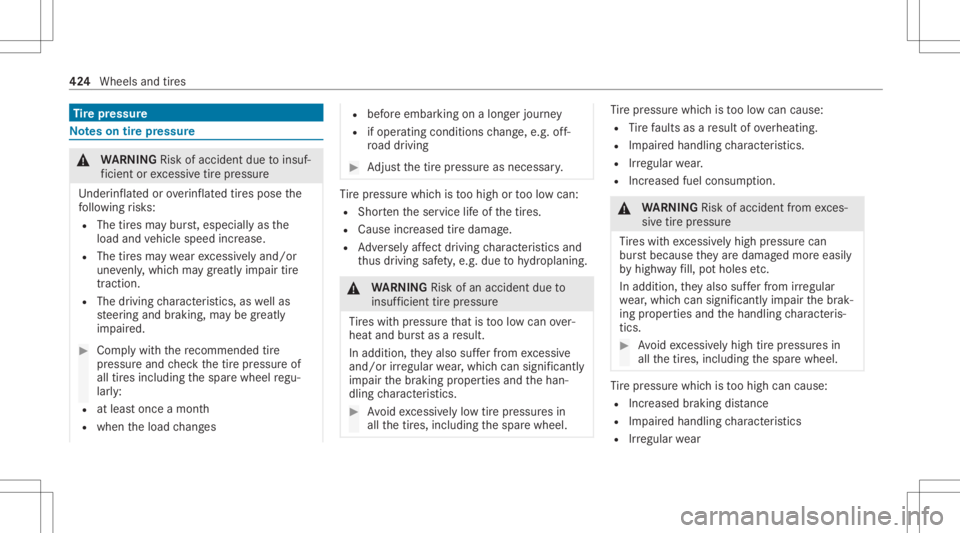
Ti
re pres sur e No
teson tirepr essur e &
WARNIN GRisk ofacci dent dueto insuf ‐
fi cie ntor excess ive tir epr ess ure
Under inflate dor ove rinf late dtir es pose the
fo llo wing risk s:
R The tires ma ybur st,especiall yas the
load andvehicle speed increase.
R The tires ma ywe arexc essiv elyand/or
une venly, whic hma ygr ea tly impair tire
traction .
R The drivin gch aract eristic s,as wellas
st eer ing and braking, maybe greatl y
im pair ed. #
Com plywithth ere comme ndedtire
pr ess ureand checkth etir epr essur eof
all tires including thespar ewheel regu‐
lar ly:
R atleas tonce amont h
R when theload chang es R
beforeembar kingon alon gerjour ney
R ifoper ating conditions chang e,e.g .of f-
ro ad drivin g #
Adjus tth etir epr essur eas neces sary. Ti
re pressur ewhic his toohigh ortoolow can:
R Shor tenth eser vice life of thetir es.
R Cause increased tiredamag e.
R Adversely affect drivi ng charact eristic sand
th us drivin gsaf ety, e.g. due tohydroplaning. &
WARNIN GRisk ofan acci dent dueto
insuf ficie nttirepr ess ure
Ti re swit hpr essur eth at istoolow can over‐
heat andburstas are sult.
In addition, they also sufferfr om excessiv e
and/or irre gular wear,whic hcan significan tly
im pair thebr aking proper tiesand thehan‐
dling charact eristic s. #
Avoid excessiv elylow tirepr essur esin
all thetir es, including thespar ewheel. Ti
re pressur ewhic his toolow can cause:
R Tire faults asare sult ofoverheating.
R Impair edhandling charact eristic s.
R Irre gular wear.
R Incr eased fuelconsum ption. &
WARNIN GRisk ofacci dent from exces‐
siv etir epr essur e
Ti re swit hexc essiv elyhigh pressur ecan
bur stbecause they aredamag edmor eeasil y
by highw ayfill, po tholes etc.
In addition, they also sufferfr om irre gular
we ar,whic hcan significan tly im pair thebr ak‐
ing proper tiesand thehandling charact eris‐
tic s. #
Avoid excessiv elyhigh tirepr essur esin
all thetir es, including thespar ewheel. Ti
re pressur ewhic his toohigh cancause:
R Increased brakin gdis tance
R Impaired handl ing charact eristic s
R Irre gular wear 42
4
Whee lsand tires
Page 427 of 570
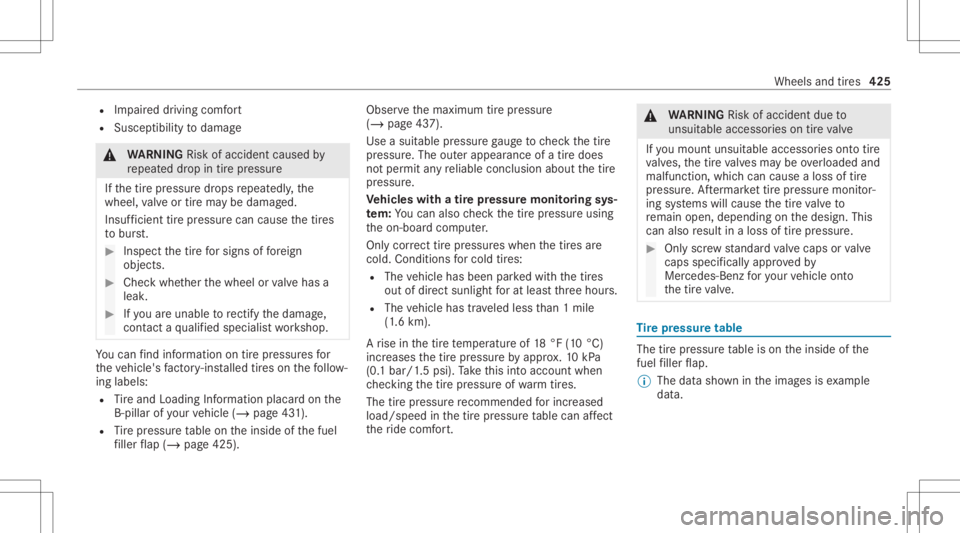
R
Impai reddr iving comfort
R Suscep tibilitytodamag e &
WARNIN GRisk ofacci dent caused by
re peat eddrop intirepr essur e
If th etir epr essur edr ops repeat edly,th e
wheel, valve or tirema ybe damag ed.
Ins ufficie nttirepr ess urecan causethetir es
to bur st. #
Inspect thetir efo rsigns offore ign
obje cts. #
Chec kwhe ther thewheel orvalve has a
leak . #
Ifyo uar eunab leto rectify thedamag e,
con tact aqu alif ied spec ialistwo rkshop. Yo
ucan find informa tionon tirepr ess ures for
th eve hicle's fact or y-ins talled tires on thefo llo w‐
ing labels:
R Tire and Loadi ngInfo rm atio nplacar don the
B‑pil larof your vehicle (/page43 1).
R Tire pressur eta ble ontheinside ofthefuel
fi ller flap (/ page42 5). Obse
rveth emaximum tirepr essur e
(/ page43 7).
Use asuit able pressur ega ug eto checkth etir e
pr essur e.The outerappear anceofatir edoes
no tper mit anyre liable conclusion aboutthetir e
pr essur e.
Ve hicl eswith atir epr ess uremonit oring sys‐
te m: Youcan also checkth etir epr essur eusing
th eon- boar dcom puter.
Onl ycor rect tirepr ess ures whenth etir es are
cold. Condition sfo rcold tires:
R The vehicle hasbeen parkedwit hth etir es
out ofdir ect sunlight forat lea stthre ehour s.
R The vehicle hastrave led less than 1mile
(1 .6 km ).
A rise inthetir ete mp eratur eof 18 °F(10 °C)
incr eases thetir epr essur eby appr ox.10 kPa
(0. 1ba r/1 .5psi ).Ta ke this int oacc ount when
ch ecking thetir epr essur eof wa rm tires.
Th etir epr es su re recomme ndedforincr ease d
loa d/spee din thetir epr essur eta ble can affect
th eride comf ort. &
WARNIN GRisk ofacci dent dueto
uns uitable accessories ontireva lve
If yo umoun tuns uitable accessories onto tire
va lves, thetir eva lves ma ybe ove rloaded and
malfunct ion,whic hcan cause aloss oftire
pr essur e.Afterm arke ttir epr es su re monit or‐
ing systems willcause thetir eva lve to
re main open, depending onthedesign. This
can also result inaloss oftirepr essur e. #
Onlyscr ew standar dva lve caps orvalve
cap sspe cifica llyapprove dby
Mer cedes-Ben zfo ryo ur vehicle onto
th etir eva lve. Ti
re pres sur etab le The
tirepr ess ureta ble ison theinside ofthe
fuel filler flap.
% The datasho wnintheimag esisexam ple
dat a. Whee
lsand tires 425